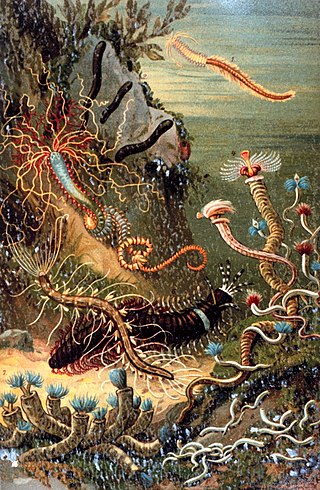
Polychaeta is a paraphyletic class of generally marine annelid worms, commonly called bristle worms or polychaetes. Each body segment has a pair of fleshy protrusions called parapodia that bear many bristles, called chaetae, which are made of chitin. More than 10,000 species are described in this class. Common representatives include the lugworm and the sandworm or clam worm Alitta.

A sclerite is a hardened body part. In various branches of biology the term is applied to various structures, but not as a rule to vertebrate anatomical features such as bones and teeth. Instead it refers most commonly to the hardened parts of arthropod exoskeletons and the internal spicules of invertebrates such as certain sponges and soft corals. In paleontology, a scleritome is the complete set of sclerites of an organism, often all that is known from fossil invertebrates.

Orthonectida is a small phylum of poorly known parasites of marine invertebrates that are among the simplest of multi-cellular organisms. Members of this phylum are known as orthonectids.

Acteonoidea is a superfamily of sea snails, or bubble snails, marine gastropod mollusks.
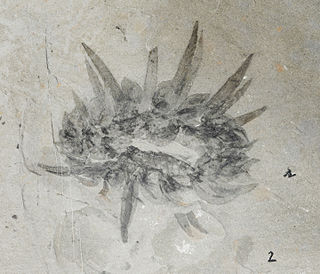
Wiwaxia is a genus of soft-bodied animals that were covered in carbonaceous scales and spines that protected it from predators. Wiwaxia fossils—mainly isolated scales, but sometimes complete, articulated fossils—are known from early Cambrian and middle Cambrian fossil deposits across the globe. The living animal would have measured up to 5 centimetres (2 in) when fully grown, although a range of juvenile specimens are known, the smallest being 2 millimetres (0.08 in) long.

In invertebrates, the term parapodium refers to lateral outgrowths or protrusions from the body. Parapodia are predominantly found in annelids, where they are paired, unjointed lateral outgrowths that bear the chaetae. In several groups of sea snails and sea slugs, 'parapodium' refers to lateral fleshy protrusions.

A chaeta or cheta is a chitinous bristle or seta found on annelid worms, although the term is also frequently used to describe similar structures in other invertebrates such as arthropods. Polychaete annelids are named for their chaetae. In Polychaeta, chaetae are found as bundles on the parapodia, paired appendages on the side of the body. The chaetae are epidermal, extracellular structures, and clearly visible in most polychaetes. They are probably the best-studied structures in these animals. Segments bearing chaetae are called chaetigers.
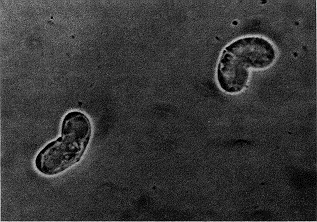
Ceratonova shasta is a myxosporean parasite that infects salmonid fish on the Pacific coast of North America. It was first observed at the Crystal Lake Hatchery, Shasta County, California, and has now been reported from Idaho, Oregon, Washington, British Columbia and Alaska.

Odontogriphus is a genus of soft-bodied animals known from middle Cambrian Lagerstätte. Reaching as much as 12.5 centimetres (4.9 in) in length, Odontogriphus is a flat, oval bilaterian which apparently had a single muscular foot and a "shell" on its back that was moderately rigid but of a material unsuited to fossilization.
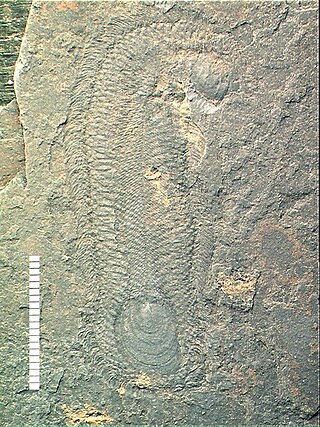
Halwaxiida or halwaxiids is a proposed clade equivalent to the older orders Sachitida He 1980 and Thambetolepidea Jell 1981, loosely uniting scale-bearing Cambrian animals, which may lie in the stem group to molluscs or lophotrochozoa. Some palaeontologists question the validity of the Halwaxiida clade.

Pyramidelloidea is a superfamily of mostly very small sea snails, marine gastropod mollusks and micromollusks within the clade Panpulmonata.
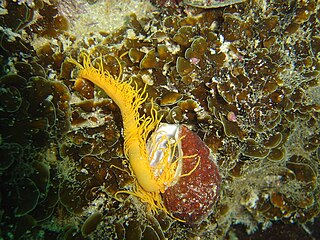
Terebellida make up an order of the Polychaeta class, commonly referred to as "bristle worms". Together with the Sabellida, the Spionida and some enigmatic families of unclear taxonomic relationship, they make up the subclass Canalipalpata, one of the three main clades of polychaetes. Like most polychaetes, almost all members of the Terebellida are marine organisms. Most are small, sessile detritivores which live in small tubes they build from mud or similar substrate, or burrow in the sand. Their central nervous system displays characteristic apomorphies.

Canadia is a genus of extinct annelid worm present in Burgess Shale type Konservat-Lagerstätte. It is found in strata dating back to the Delamaran stage of the Middle Cambrian around 505 million years ago, during the time of the Cambrian explosion. It was about 3 centimeters in length. Charles Doolittle Walcott named Canadia in 1911 after Canada, the country from which its remains have been found. 28 specimens of Canadia are known from the Greater Phyllopod bed, where they comprise 0.05% of the community.

The order Microconchida is a group of small, spirally-coiled, encrusting fossil "worm" tubes from the class Tentaculita found from the Upper Ordovician to the Middle Jurassic (Bathonian) around the world. They have lamellar calcitic shells, usually with pseudopunctae or punctae and a bulb-like origin. Many were long misidentified as the polychaete annelid Spirorbis until studies of shell microstructure and formation showed significant differences. All pre-Cretaceous "Spirorbis" fossils are now known to be microconchids. Their classification at the phylum level is still debated. Most likely they are some form of lophophorate, a group which includes phoronids, bryozoans and brachiopods. Microconchids may be closely related to the other encrusting tentaculitoid tubeworms, such as Anticalyptraea, trypanoporids and cornulitids.

Errantia is a diverse group of marine polychaete worms in the phylum Annelida. Traditionally a subclass of the paraphyletic class Polychaeta, it is currently regarded as a monophyletic group within the larger Pleistoannelida, composed of Errantia and Sedentaria. These worms are found worldwide in marine environments and brackish water.
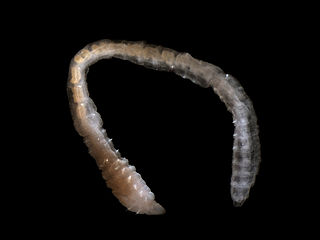
Scolecida is an infraclass of polychaete worms. Scolecids are mostly unselective deposit feeders on marine detritus.

The annelids, also known as the segmented worms, comprise a large phylum called Annelida. It contains over 22,000 extant species, including ragworms, earthworms, and leeches. The species exist in and have adapted to various ecologies – some in marine environments as distinct as tidal zones and hydrothermal vents, others in fresh water, and yet others in moist terrestrial environments.

Sedentaria is a diverse clade of annelid worms. It is traditionally treated as a subclass of the paraphyletic class Polychaeta, but it is also a monophyletic group uniting several polychaetes and the monophyletic class Clitellata. It is the sister group of Errantia.

Pleistoannelida is a group of annelid worms that comprises the vast majority of the diversity in phylum Annelida. Discovered through phylogenetic analyses, it is the largest clade of annelids, comprised by the last common ancestor of the highly diverse sister groups Errantia and Sedentaria and all the descendants of that ancestor. Most groups in the Clade find their ancestors within the Cambrian explosion when Annelid diversity expanded dramatically. The Pleistoannelida clade covers a variety of traits. However, the evolution of simple to complex eyes, developed papillae for burrowing, and for some specialized radioles for feeding can be seen universally across every species. New findings have discovered the range of Annelid diversity have led to uncertainty if groups with developed ancestral traits should remain within the clade. Furthermore, there's been a lack of recently discovered Annelid traits being used in the categorization of groups within the clade, leading to many hypothesis on how to do so and which should remain within the clade. Currently three smaller clades that were originally a part of the groups Errantia and Sedentaria have been proven to fall outside while still being connected to the basal groups.

Orbiniida is an order of small polychaete worms in the phylum Annelida. It is the earliest diverging clade in Sedentaria. Along with Protodriliformia, this order is composed of meiofaunal marine worms formerly known as "archiannelids". These worms inhabit the marine interstitial ecosystem, the space between sand grains.

















